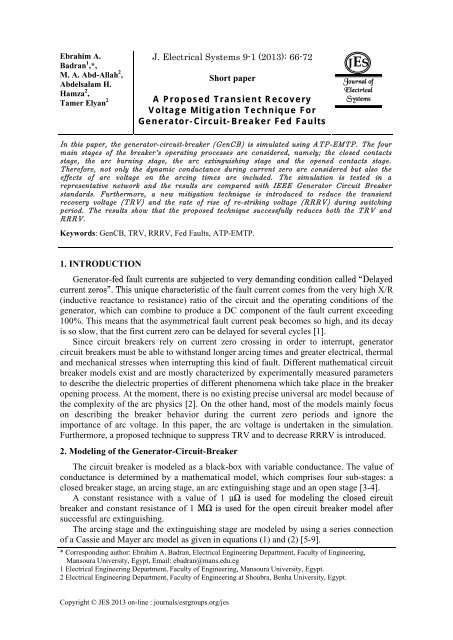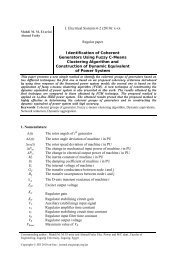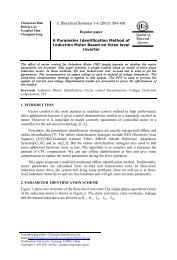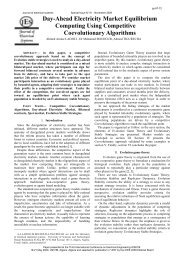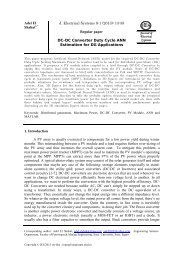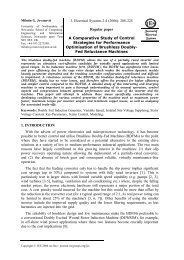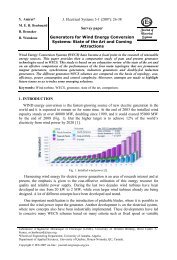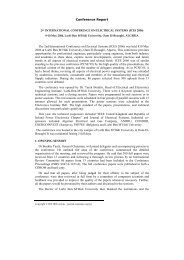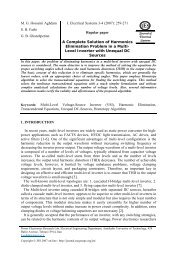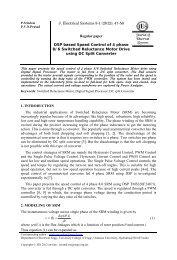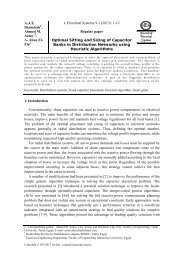Short paper A Proposed Transient Recovery Voltage Mitigation ...
Short paper A Proposed Transient Recovery Voltage Mitigation ...
Short paper A Proposed Transient Recovery Voltage Mitigation ...
Create successful ePaper yourself
Turn your PDF publications into a flip-book with our unique Google optimized e-Paper software.
Ebrahim A. Badran et al: A <strong>Transient</strong> <strong>Recovery</strong> <strong>Voltage</strong> <strong>Mitigation</strong> Tech. for GenCB Fed FaultsFig. 6: The voltage across the circuit breaker in case of 20 kA short circuit currentfor the three-phase modelPhase CPhase APhase BFig. 7: The crest value of transient recovery voltage and RRRV of 20 KA short circuitfor the three-phase model25[kV]15525[kV]155-5-5-15-25-15-35Without-25With Suppressor-450 5 10 15 20 25 30 35 [ms] 40(file g.pl4; x-var t) v:XX0023-XX0024-350 5 10 15 20 25 30 35 [ms] 40(file g.pl4; x-var t) v:XX0021-XX0022Fig. 8: <strong>Voltage</strong> across the circuit breaker at 20 kA short circuit without andwith C=300 nF and R=30 Ω suppressor25.00[kV]18.7512.506.250.00-6.25Without-12.50-18.75WithSuppressor-25.000 5 10 15 20 25 [ms] 30(file improvedCB2.pl4; x-var t) v:X0001A-X0002A v:X0001B-X0002B v:X0001C-X0002CFig. 9: <strong>Voltage</strong> across the circuit breaker at 20 kA short circuit without and with C=300 nF andR=30 Ω suppressor in case of three-phase modelTable 2 shows the TRV, RRRV and time to crest of 20 kA short circuit current at C-Rsuppressor of R=30 Ω and C varies from 40 nF to 300 nF. It is noticed that as thecapacitance increases the TRV and RRRV decreses while the time to crest increases.Fig. 10 shows the TRV versus the capacitance value of the proposed C-R suppressor. Itis noticed that as the value of surge capacitance increases the TRV decreases. The TRV70
J. Electrical Systems 9-1 (2013): 66-72decreased by 5.622 kV when the capacitance increases from 40 nF to 300 nF, at 20 kAshort circuit. As the short circuit current increases from 20 kA to 130 kA at capacitance of40 nF, TRV decreases by 4.198 kV.Table 2: TRV, RRRV, and the time to crest of TRV at 20 kA in case of C-R suppressorswith R=30ΩCapacitance (nF) TRV (kV) RRRV (kV/µs) Time to crest of TRV(µs)40 39.512 1.531 25.880 37.912 1.282 34.8120 36.818 1.044 41.5160 35.978 0.893 47.4200 35.292 0.791 52.5240 34.712 0.715 57.1280 34.209 0.659 61.1300 33.980 0.634 63.1T R V ( k V )4 03 93 83 73 63 53 43 33 23 13 02 92 82 78 0 k A1 0 0 k A1 3 0 k A0 4 0 8 0 1 2 0 1 6 0 2 0 0 2 4 0 2 8 0 3 2 0c a p a c i t a n c e ( n f )2 0 k A4 0 k A6 0 k AFig. 10: TRV Vs capacitance of suppressor with R=30 Ω at different short circuit currentR R R V ( k V / f )4 . 24 . 03 . 83 . 63 . 43 . 23 . 02 . 82 . 62 . 42 . 22 . 01 . 81 . 61 . 41 . 21 . 00 . 80 . 62 0 k A4 0 k A 6 0 k A1 0 0 k A0 4 0 8 0 1 2 0 1 6 0 2 0 0 2 4 0 2 8 0 3 2 0c a p a c i t a n c e ( n f )8 0 k A1 3 0 k AFig. 11: RRRV Vs capacitance of suppressor with R=30 Ω at different short circuit currentFig. 11 shows the RRRV versus the capacitance of the proposed C-R suppressor. It canbe seen that as the value of capacitance increases the RRRV decreases. When the value ofcapacitance increases from 40 nF to 300 nF at 20 kA short circuit the RRRV decreases by0.897 kV/µs. The RRRV increases by 2.542 kV/µs when the short circuit current increasesfrom 20 kA to 130 kA at capacitance of 40 nF.The change of time to crest with the capacitance values at different short circuit currentsis shown in Fig. 12. It is noticed that as the value of the capacitance increases the time tocrest increases. Also, it can be found that at a certain value of the capacitance, the time tocrest increases as the short circuit current decreases. The time to crest is increased by about37.3 µs as the surge capacitance increased from 40 nF to 300 nF at 20 kA short circuitcurrent. The time to crest decreases from 25.8 µs to 10.2 µs as the short circuit currentincreases from 20 kA to 130 kA, at capacitance of 1 µF.71
Ebrahim A. Badran et al: A <strong>Transient</strong> <strong>Recovery</strong> <strong>Voltage</strong> <strong>Mitigation</strong> Tech. for GenCB Fed FaultsT i m e t o c r e c t ( s )6 56 05 55 04 54 03 53 02 52 01 51 06 0 k A8 0 k A1 0 0 k A1 3 0 k A0 4 0 8 0 1 2 0 1 6 0 2 0 0 2 4 0 2 8 0 3 2 0c a p a c i t a n c e ( n f )2 0 k A4 0 k AFig. 12: The time to crest Vs capacitance of suppressor with R=30 Ω at different short circuit current5. ConclusionThe voltage across the GenCB oscillates with a high frequency and reached a high valuewhich can be as high as 2 pu in very small time which can be as low as 6 µs. In this <strong>paper</strong>,the proposed mitigation technique using C-R suppressor effectively reduced both TRV andRRRV. As the capacitance of C-R suppressor increases, the TRV and RRRV aredecreased, while the time to crest is increased. At a certain value of capacitance, as theshort circuit increases, the TRV and time to crest are decreased while RRRV is increased.REFERNCES[1] Václav Ježek, Prespective Generator Circuit Breaker, Intensive Programme on RenewableEnergy Sources, 107-110, 2010.[2] IEEE Standard for AC High-<strong>Voltage</strong> Generator Circuit Breakers Rated on a SymmetricalCurrent Basis, IEEE Standard C37.013–1997.[3] S. Y. Leung, Laurence A. Snider and Cat S. M. Wong, SF6 Generator Circuit BreakerModeling, International Conference on Power Systems <strong>Transient</strong>s, IPST’05, Montreal, Canada,2005.[4] P. H. Shavemaker and L. Van Der Sluis, The Arc Model Blokset, 2 nd IASTED InternationalConference on Power Engineering Systems, 1310-1315, 2002.[5] R. P. P. Smeets and W. A. van der Linden, The Testing SF6 Generator Circuit Breakers, IEEETransactions on Power Delivery, 13(4), 1188-1193, 1998.[6] Grega Bizak, Peter Zunko and Dusan Povh, Combined Model of SF6 Circuit Breaker for Use inDigital Simulation Programs, Transactions on Power Delivery, 19(1), 174-180, 2004.[7] G. Ala and M. Inzerillo, An Improved Circuit Breaker Model in Models Language for ATP-EMTP, International Conference on power Systems <strong>Transient</strong>, IPST’99, 493-498, 1999.[8] R. P. P. Smeets and L.H. Paske, Testing of SF6-and Vacuum Generator Circuit breakers,International Conference on Electric Power equipment-Switching Technology, 146 -150, 2011.[9] A. Borghetti, F. Napolitano, C.A. Nucci, M. Paolone, M. Sultan, N. Tripaldi, <strong>Transient</strong><strong>Recovery</strong> <strong>Voltage</strong>s in Vacuum Circuit Breakers Generated by the Interruption of InrushCurrents of Large Motors, International Conference on power Systems <strong>Transient</strong>, (IPST2011) inDelft, the Netherlands June 14-17, 2011.72


